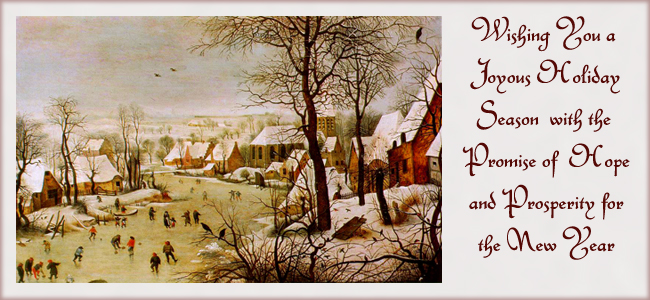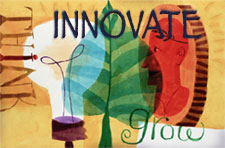

2010 at Barnes & Conti
Kim Barnes, Barnes & Conti CEO
This has been an interesting year for many of us. (I am reminded of the old Chinese curse, “May you live in interesting times!”) It has been a year of change and loss as well as excitement and opportunity.
For some of us, it has been a year of travel—mainly to the emerging markets in China, Russia, India, Brazil, Chile, and Eastern Europe. There is a wonderful sense of hope and optimism in these countries; for them, the future has never looked more promising. At the same time, we see many of our colleagues and client organizations working ever harder without an easing of the restrictions they have been under.
Some of our friends and colleagues were without jobs for part of the year—we are happy to see that many of them are now back to work in exciting organizations. They made the—sometimes unplanned—break serve them as a time to develop new connections and new ideas, making them even more valuable to their new employers.
One of my favorite and most uplifting moments this year came in a conversation with one of our partners in Chile. He mentioned that the amazingly quick—though still incomplete—recovery from the earthquake, their success in the football World Cup, and finally the extraordinary rescue of the trapped miners gave Chileans a new view of themselves. Having lived through a terrible dictatorship for so many years, doing things “the Chilean way” had been a rather sarcastic term—but now it had become positive. My colleague smiled and I was struck by how quickly it had been possible to turn attitudes around. Of course, things there have changed for the better slowly and surely over a period of years, but it took these dramatic events for people to catch up with themselves.
My wish for everyone for the new year is that we all look down, or up, or out, and notice that things are improving—though far too slowly—and that we allow ourselves to celebrate what we have and what we have learned. We are wiser, perhaps a little tougher and more thoughtful than before, a little less prone to wishful thinking—but maybe more open to new ideas and change.
This year was Barnes & Conti’s 25th anniversary—we kept meaning to celebrate it, but somehow the year got away from us. So we will celebrate our 26th anniversary next year and we hope that many of you can be part of our yearlong festival of appreciation to our customers, colleagues, partners, and friends. To begin the celebration, we are making a contribution to The Heifer Project in your honor. We have always liked their philosophy of investing in people so they can enjoy the fruits of their own intelligence and hard work.
We wish everyone a joyous holiday season and a happy, healthy, prosperous, and fascinating new year—with a new, can-do view of ourselves, our families, our businesses, our nations, and our world.
In This Issue:
Fortune 500 Innovation: Positive Outcomes and a Journey to Success by Nelson Soken
Exercising Influence Public Offerings Announced
The Smoking Oven: Lessons in Gratitude by Lauren Powers
The Cherpumple: Innovation? Or What? by Joel Kleinbaum
The Tenth Annual Barnes & Conti Virtual Feast
- Appetizer or Main Dish: Duck Confit with Brussel Sprouts (Kim Barnes)
- First Course or Main Dish: Seafood Gumbo (Janne Rochlin)
- Main Dish: Choucroute Garnie—Braised Sauerkraut with Sausages (Joel Kleinbaum)
- Dessert/Sweet: Ginger Crisps (Dineen Digiacomo)
- Dessert: Grandma Robbins’ Apple Cake (Eric Beckman)
- Dessert/Sweet: Sugar Hubbard “Pumpkin” Bars (Kim Barnes & Don Bryant)
Featured Art (above) “Winter Landscape with a Bird Trap” by Pieter Bruegel the Elder
Featured Art, Virtual Feast (next page): “Christmas Dessert” by Kevin Turcotte (the artist is Elaine Turcotte’s brother)
 Fortune
500 Innovation: Positive Outcomes and a Journey to Success
Fortune
500 Innovation: Positive Outcomes and a Journey to Success
Nelson Soken, Ph.D.
Over the past 18 months, I have spearheaded a major roll-out of Managing Innovation: Driving Ideas from Strategic Initiative to Value Creation to about 1000 people in a Fortune 500 company. Course participants have included a wide range of employees across different levels of the organization as well as multiple business units. Participants have included researchers, engineers, administrators, information technology and manufacturing personnel, as well as upper level managers, directors, and vice presidents.
The course has generated a great deal of interest in and enthusiasm for innovation. Perhaps more importantly, the value in creating a common language about innovation (i.e. what is innovation) and creating an environment for people across the organization to have a conversation about innovation cannot be underestimated.
The training effort continues with momentum through “viral” word of mouth among both management and employees. Innovation—and innovation management—is a process or journey that takes time to complete. Even the best ideas take time to generate value, and 18 months is not a long time. Furthermore, changing a culture and getting people to shift their mindset also takes time. However, even at this relatively early stage, I can list some positive outcomes that will continue to foster innovation and benefit the company.
Innovation Space: Management has been discussing the effect of the physical space on innovation. They now recognize that physical space can either promote or inhibit creativity and idea generation. A design for an “innovation space” has been created to show how the physical space could be modified. The organization continues to explore new options.
Current Projects: At least 5-10 current projects in information technology and product development have incorporated concepts from the course into their project activities and planning. Tools and concepts from the course have given projects and project teams a common language for further development.
Brainstorming/Idea Generation: The ideation and feedback tools in Managing Innovation have fostered multiple “brainstorming” sessions to capture new ideas for intellectual property and solve critical current business problems facing the company.
But I’d like to save the last words for the positive outcomes for the participants. Evaluations have been consistently high, feedback has been very positive, with several enthusiastic comments. One such example is below:
“Thanks for all your help with the brainstorm session last week! The brainstorming was a great change of pace from our usual daily activities and yielded significantly more concepts than we typically come up with using our previous methods. I liked coming up with a cohesive solution from many separate ideas... I look forward to doing future sessions. We were extremely happy with the number of potential concepts we came up with.”
Equipping an organization for innovation requires a change in mindset and the development of appropriate skills and behaviors. Change does not happen overnight! It takes patience, nurturing, and deliberate support from leadership. In my view, Managing Innovation is an ideal way to start your organization on the path to success because it introduces a common framework of innovation and gets people talking to each other.
Over time, I look forward to seeing the value created by companies who have taken the challenge of innovation seriously and transformed their companies by adopting the concepts that they learned in Managing Innovation and truly embracing it as their own.
Nelson Soken, Ph.D., is a Senior Consultant with Barnes & Conti.
 Exercising Influence Public Offerings Announced
Exercising Influence Public Offerings Announced
We’re pleased to announce four open-registration offerings of our globally-popular Exercising Influence program. Two programs will be offered on the West Coast, and two on the East Coast. Date dates are below:
Berkeley, California:
January 19-20, 2011
April 13-14, 2011
Philadelphia, Pennsylvania:
February 28-March 1, 2011
June 14-15, 2011
In case you’re not familiar with this course, here’s what the training director of a technology research and development company said:
“The fact that I view this course very positively goes without saying, and I think the content will be very helpful in the day-to-day work of the participants. I particularly like the practice opportunities—especially the ‘real-life’ scenarios.”
All four courses will be taught by Barnes & Conti Chief Learning Officer Janne Rochlin. Space is very limited; please register soon.
 The Smoking Oven: Lessons in Gratitude
The Smoking Oven: Lessons in Gratitude
I had the most unexpectedly wonderful Thanksgiving despite having no oven. For that, I am grateful!
On the Tuesday before the holiday, I decided to use the self-clean function of my one-year-old-oven—one year to the day; this would become a very important time frame! As luck would have it, 40 minutes into the cleaning cycle—and after a lot of heat and smoke—my oven blew out the electricity in our home and in my range.
Just as the smoke was pouring and the electricity was blowing, my husband walked into the house with a fresh 20-pound turkey from the Farmer’s Market. The big bird was for the dinner we would be cooking and serving for 14 people at our home in just two days. No biggie, I thought… we’ll figure it out. I remained remarkably calm, for me.
I called the appliance store, got referred to the appliance repair service, and had someone come out on Wednesday. We learned that our warranty was up that Tuesday, and we just made it to the day…so here goes my my first expression of immense gratitude…the defunct oven was still under warranty! Naturally, they needed to order a part, so our home oven was not going to be available to cook the twenty-pounder. No worries, I had a plan B.
Our corner grocery, Garden Fresh (23rd and Fairmount for those of you who live in Philly) offered to cook it for us in their oven if we brought our twenty-pounder in by 7am on Thursday. Friends and family offered to bring more than they originally offered. I also re-engineered recipes to be burner- as opposed to oven-friendly. In addition, I pressed into service another oven (my mother’s) for the remaining dishes which were carted over ready to be popped into mom’s oven in just enough time to be still warm for the dinner guests. The whole effort was an all-out family collaboration. The most fun part was getting everything ready. At the end of the day, everyone commented on what an amazing Thanksgiving it had been!
So how did something that could have been so awful become so fabulous? I am grateful (2nd expression of gratitude) to work for Barnes & Conti because it has given me the tools that I drew upon to make this day of Thanksgiving a success. I used my influence, creativity, negotiation, problem-solving, teamwork, innovation and intelligent risk-taking behaviors to bring about a superb and delicious outcome. Everyone kicked in for this mini crisis… and helped me rediscover the value of relationships, networks, planning tools, open-mindedness, flexibility, and risk mitigation strategies.
And on top of it all, we tried the “cherpumple” discussed on our recent blog (and reprinted below), baked and brought by my sister. As a risk mitigation strategy, I made sure we had other desserts just in case! It was not too bad, not that it was so good either. But, it reinforced the idea that one should always test their assumptions. And it also demonstrated that groups love to be entertained by spectacle, in this case by a “spectacular” dessert that they’ve seen in the news and on YouTube!
Now for my third expression of gratitude, I am grateful to have had this experience and remain hopeful that my future Thanksgiving celebrations bring me such joy and happiness. Happy holidays to you all and may you find gratitude and happiness by turning everyday potential setbacks into unexpected wonderful opportunities.
The Cherpumple: Innovation? Or What?
by Joel Kleinbaum, reprinted from the Barnes & Conti blog
The cherpumple—that holiday dessert in which a cherry pie is baked in a white cake, and a pumpkin pie is baked in a yellow cake, and an apple pie is baked in a spice cake AND the whole thing is pasted together in layers with cream cheese frosting—has gone mainstream. The Wall Street Journal featured the cherpumple—and printed a recipe—this past November.
The cherpumple is the invention of one Charles Phoenix of Los Angeles. According to the the Wall Street Journal, Phoenix was “inspired to combine all my family’s traditional holiday desserts into one.”
I can’t help but ask, “why?”
Confession: all of us at Barnes & Conti like to eat. Many of us—this blogger included—are better than average cooks. Why shouldn’t we be? Our office is located only a mile or two from Berkeley’s famous “gourmet ghetto.” In the San Francisco Bay Area, we have access to wonderful ingredients year round and superb restaurants for every budget, encompassing any cuisine you can think of. Again I ask “why the cherpumple?”
The cherpumple—in my not so humble opinion—would not make it through our “Innovation Journey.”* Why not? Because the aim of the innovation journey is to create value. How does the cherpumple rate on the value scale?
First of all, it’s not cheap. The recipe calls for three frozen pies and three cake mixes. And the investment in time is huge. The pies have to cool before being baked in the cake. Then the cakes have to cool before being assembled. If the thing doesn’t collapse, it must make an impressive presentation. But what does it taste like? I sincerely have to ask, can you really take a mouthful that encompasses cherry, apple, and pumpkin—not to mention the cake mixes—all at once? It sounds rather disgusting to me.
Our Managing Innovation program identifies six forms of value that innovation delivers: economic, strategic, social, environmental, aesthetic, and personal. A true innovation will deliver at least one form of value. An innovative holiday dish, should save time or money (economic), or be less wasteful (environmental), or taste wonderful and look great (aesthetic). The cherpumple, instead of being an innovation, seems to be a celebration of indiscriminate gluttony. Perhaps the “innovation”—if it’s really an innovation at all—of the cherpumple is to solve a family argument regarding the dessert: just have them all together at once in their goopy, gloppy, glory!
Here’s to a truly innovative, delicious, and thankful feast to all our readers.
*Quotes from “For Those Who Can’t Decide on Dessert, Here’s the Dish” by Geoffrey Fowler, The Wall Street Journal, November 6, 2010
Events, Trade Shows, and Happenings
ASTD Conference and Expo
May 22-25, 2011
Orlando, FL
The Newsletter Continues with Our Virtual Feast...